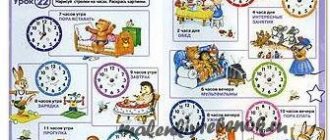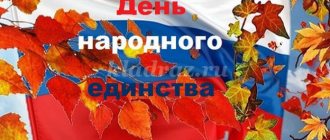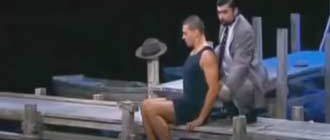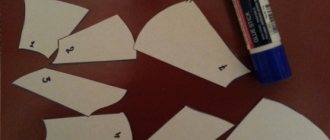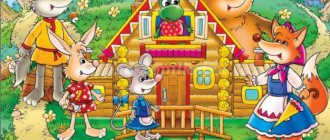Summary of OOD in the senior group “National Unity Day”
Summary
of OOD in the senior group
“National Unity Day”
Main educational area: “Cognitive development”.
Integration of educational areas: social and communicative development, speech development, physical development.
Types of children's activities: communicative, cognitive and research.
Goal: education of a humane, spiritual and moral personality, worthy future citizens of Russia, patriots of their Fatherland.
Objectives: - to consolidate the idea that our country is huge, multinational, called the Russian Federation, Russia;
— consolidate knowledge about the geographical location of the country on the map;
— expand the understanding of public holidays, the holiday “National Unity Day”, the meaning and history of its origin;
— provide basic information about the history of Russia;
— to develop knowledge about the multinationality of our country;
— consolidate knowledge about the flag, coat of arms and anthem of Russia;
— cultivate respect for other peoples and cultures;
- develop auditory attention and memory.
Equipment and materials: sheets of paper according to the number of children, projector, laptop, magnetic board, presentation “National Unity Day”, audio recording of the Russian anthem, flag and coat of arms of Russia.
OOD progress:
- I won’t get tired of enjoying the lark’s song, I won’t exchange the sweet side for anything! The warm wind will bring the aroma of currants, So what is more expensive? - There is nothing more expensive... (Motherland)
- A person has one natural mother, and he has one homeland. Her people love her deeply. What is the Motherland?
Homeland.
Homeland is a big, big word! Let there be no miracles in the world, If you say this word with your soul, It is deeper than the seas, higher than the skies! It fits exactly half the world: Mom and Dad, neighbors, friends Dear city, home apartment, Grandmother, school, kitten... and me. A sunny bunny in your palm, a lilac bush outside the window, and a mole on your cheek - This is also the Motherland. (author Tatyana Bokova)
- What is the name of our Motherland? (Russia)
View the presentation “National Unity Day”
— There are many different beautiful countries in the world and every people loves their homeland most of all. You and I were born in Russia, we are Russians. Do you love your country? (children's answers)
For what?
(children give their own answers, some find it difficult to answer the question).
- Who can answer this question?
Citizens of a country feel love for their homeland simply because they live in it. After all, we all have one homeland. Our Motherland is very large, beautiful and rich. Russia occupies the largest and most extensive territory from Europe to Asia. Only in our country there is the polar zone, and the tundra, and the taiga, and the steppe, and the tropics. (Look at the map). — Do only Russians live in Russia? (no)
- What peoples inhabit our country? (children's answers)
— Yes, our country is inhabited by people of different nationalities - Ukrainians, Belarusians, Tatars, Karelians, Chuvash, Bashkirs, Yakuts, Dagestanis, Adygeis, Mordovians, Komi, Udmurts, Khanty, Mansi, Germans, Tajiks, Armenians, Azerbaijanis, Georgians, Shors and many - many more - more than a hundred nationalities in all.
— Which nationality do you think is better? (children's answers)
- Different peoples inhabit Russia, but they are all united into a single family by a common Motherland, mutual respect and friendship. Therefore, it is impossible to say which nationality is better - we are all equal, all special.
Phys. just a minute:
In our country the mountains are high, (hands up, on tiptoes)
The rivers are deep (crouched down)
,
The steppes are wide (arms to the sides)
,
The forests are large (we draw a circle with our hands)
,
And we are guys like that! (thumbs up)
— On November 4, all of Russia will be about. This is a holiday of patriotism, mutual assistance and unity of all Russian peoples.
— Guys, how do you understand what unity is? (Unity is when all people are together)
Experimentation: one child is asked to tear a stack of paper in half (the child cannot tear the paper)
, then each child is asked to tear one sheet of paper into two parts. The teacher draws an analogy: when we are all together, friendly and united, we cannot be defeated, but if we are alone, like one piece of paper, then it will be easy to defeat us.
—Who are patriots? (These are people who love their Motherland and are always ready to defend it)
— The National Unity Day holiday has a very ancient history. Listen to her. It all started 400 years ago, in the 17th century. Then a terrible time began in Russia, which was called the Troubles (everything was mixed up, nothing could be understood)
. There was no king in the country, the laws were not respected. The Poles took advantage of this. They attacked our country. They captured Moscow and the main fortress of the capital - the Kremlin. It was difficult for the residents of Moscow; the invaders destroyed their houses and desecrated their churches. But there were brave people - Kuzma Minin and Dmitry Pozharsky. They gathered an army, prayed to the Heavenly Intercessor icon of the Most Holy Theotokos and went to liberate the capital of Russia - Moscow and the main fortress - the Kremlin.
Russian soldiers fought for two months and on November 4 defeated the enemy and drove him out of the Kremlin. Rus' again became autocratic, that is, independent. In Moscow, on Red Square, in honor of the victory over the Poles, a bronze monument to Minin and Pozharsky was erected so that people would not forget and honor the heroes of their country. It is in honor of this event that “National Unity Day” is celebrated.
Russia did not immediately become a strong state; the country's power gradually increased. In severe trials and battles, the will was tempered, and the unity of the people was strengthened.
400 years have passed, during which time different countries tried many times to conquer Russia, but they failed, all people stood up to defend their country. (The story is accompanied by a display of illustrations from the presentation)
- Guys, let's check which of you is the real citizen of our country? (Listening to an audio recording of the Russian anthem while standing)
— Tell me, please, what is the name of this music? (Hymn)
That's right - this is the anthem - the main musical work of our country. It is performed on the most solemn occasions and all people stand as a sign of respect and pride for their country.
— Every Russian knows and respects the main symbols of his country - the anthem, coat of arms and flag. We have already heard the anthem. Here in front of us is the coat of arms of Russia. What is depicted on our coat of arms? (children's answers).
- Please note that on our coat of arms the eagle has two heads, which means that it will not allow a single enemy to pass through. In the paws of the eagle are symbols of power - a scepter and an orb, such as the Russian tsars had in the old days.
- And this is our flag. Guys, list what colors it consists of (they are called).
The white stripe - a symbol of purity of intentions and nobility - means that our state has no evil intentions, it treats all countries honestly and openly. The blue stripe, a symbol of peace, indicates that Russia is against war. The red stripe - a symbol of courage - means that every citizen of Russia is ready to defend the freedom and honor of the Motherland from enemies.
Result:
— Well done guys, you know a lot about our homeland Russia. Today you learned more about the holiday “Day of National Unity”, about our Motherland - Russia, about the state symbols of the Russian state. I hope that you will always love and be proud of our Motherland and when you grow up, glorify it with your deeds. Russia will always be proud of you.
Pedagogical project “National Unity Day”
Project
"Day of National Unity"
Project implementation timeline:
From October 30 to November 3, 2022.
Project type:
cognitive-speech.
By number of participants:
group.
By duration:
short.
Project participants
: children of the older group of different ages, parents of pupils, teaching staff of the kindergarten.
Educational areas:
“Cognitive development”, “Social and communicative development”, “Speech development”, “Artistic and aesthetic development”, “Physical development”, play activities.
Target:
Formation of children's ideas about the heroic past and present of the Russian people.
Tasks:
— Give an idea of the holiday “National Unity Day.
To awaken in children a feeling of love for their city, region, respect for its traditions and customs.
Fostering a sense of pride in the strength of Russia, respect for Russian soldiers, national heroes, and a desire to imitate them.
Expected results:
Improving the level of children's knowledge about their country.
— Increasing the level of parental knowledge.
— Formation of the first feelings of patriotism in children: pride in their Motherland, respect for traditions.
— Showing children’s interest in events taking place in the country.
Planned results:
If, during the implementation of the project, children acquire knowledge about the history of the region, country, symbols, and attractions; they will know the names of those who glorified their Motherland; will begin to show interest in the events of the life of the country, and reflect their impressions in productive activities, then we can assume that the goal and objectives of the project have been fulfilled.
Project methods:
•
verbal:
conversations, consultations for parents, stories, reading fiction and educational literature, explanations, praise, dialogue;
• visual:
use of illustrations, paintings, photographs, drawings, presentations;
• gaming:
didactic games, role-playing games, surprise moments, situations;
• practical:
travel, observations, problem solving.
The project is being implemented in 3 stages.
Stage 1 – preparatory.
The goal is
to determine the goals and forms of interaction between the subjects of the process.
Tasks of this stage:
1.
Setting goals and objectives, determining directions, choosing methods, techniques, forms, developing notes.
2.
Selection and study of methodological, popular science and fiction literature on this topic.
3.
Selection of illustrative material, games (didactic, role-playing, board games), musical accompaniment, attributes for gaming and cognitive activities.
4.
Creating conditions for children's artistic, productive and playful activities.
5.
Drawing up an action plan with children with the participation of parents.
